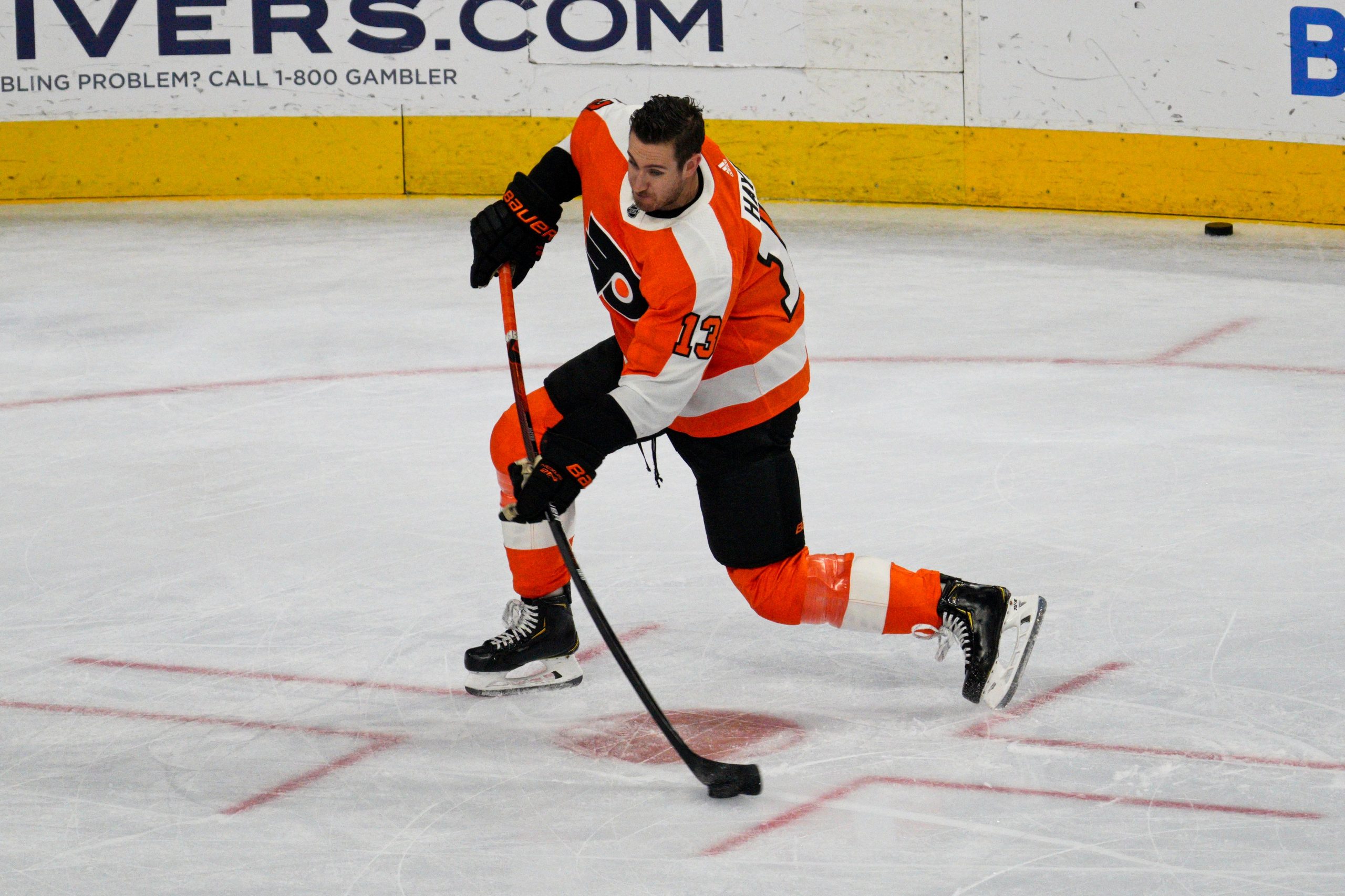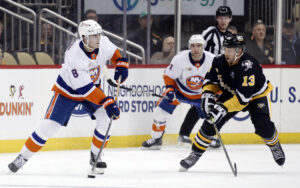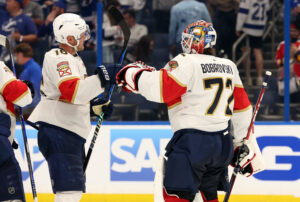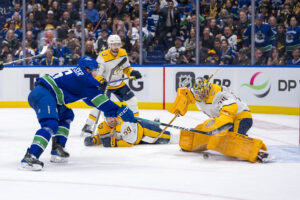Player development seems to always result in more questions than answers. How likely is it for a top pick to pan out? What makes a player a “steal”? Last Word On Hockey will be starting a new series on how to properly develop prospects from all different spots throughout the draft. This week’s piece involves draft picks in the back half of the first round and how they were used early in their careers.
NHL Player Development Of First-Round Picks
In the span of 2005 through 2015, there were 84 total selections made between 16th overall and 30th overall on forwards playing in North America. Looking at all 84 forwards, they were split into different categories. Those categories were “Forwards Deemed NHL-Ready and Brought In Immediately When Ready,” “Forwards Near NHL-Ready and Brought In Immediately When Near-Ready,” “Forwards Rushed Slightly,” “Forwards Rushed,” “Forwards Forced,” “A Little Patience,” “Patience,” and “Too Much Patience.”
There were four forwards who fell into the first category on the list. Those four players are Claude Giroux, Mathew Barzal, Kevin Hayes, and Mark Jankowski. In this piece, we will look at the two players who made their NHL impacts in their DY+5 or later season: Hayes and Jankowski.
Kevin Hayes
Hayes, drafted 24th overall by the Chicago Blackhawks in the 2010 NHL entry draft, came out of the Massachusetts high school system with the Noble & Greenough School. In his DY-1 season, he scored 28 goals and 27 assists for 55 points in just 23 games, for 2.391 points per game. That ranked second out of the 84 forwards in DY-1 production, albeit in a very weak league. Hayes followed that season up with 25 goals and 44 assists for 69 points in 29 games, for 2.379 points per game. That ranked fourth out of those same 84 forwards in DY production.
After being drafted, Hayes would join Boston College at the NCAA level and play four seasons with them. There, he scored four goals and 10 assists for 14 points as a true freshman in 31 games. That was good for 0.452 points per game, ranking 79th out of 82 forwards still outside the NHL in DY+1 production. He followed that up with seven goals and 21 assists for 28 points in 44 games, for 0.636 points per game. That ranked 58th out of 70 forwards still outside the NHL in DY+2 production.
Final Two NCAA Seasons
In his junior season with Boston College, Hayes would score six goals and 19 assists for 25 points in 27 games, for 0.926 points per game. That ranked fifth out of 46 forwards still outside the NHL in DY+3 production. Then, finally, Hayes would play his final NCAA season. As a senior, he scored 27 goals and 38 assists for 65 points in 40 games, for 1.625 points per game. That ranked first out of 30 forwards still outside the NHL in DY+4 production.
After all four collegiate seasons and a very successful senior season, Hayes would make the jump to the NHL. However, it would not be with the team who drafted him. Instead, the Blackhawks and Hayes could not come to an agreement, and he instead signed with the New York Rangers.
Professional Development
Hayes would play exclusively in the NHL as a rookie, averaging 13:02 time on ice per game across 79 games. In that small role, Hayes scored 17 goals and 28 assists for 45 points. He would finish top-10 in Calder Trophy voting that season. Analytically, Hayes proved solid. His even-strength offence goals above replacement (EVO) was a strong 4.7, while his even-strength defence goals above replacement (EVD) was a not-so-good -0.1. However, for a rookie, those stats are solid, and his wins above replacement (WAR) and goals above replacement (GAR) reflected that, with scores of 1.1 and 5.5, respectively.
In his second NHL season, Hayes would play another 79 games and average 13:40 per game, a slight increase in the role. Despite that increased role, he would take a step back with point production. He would score 14 goals and 22 assists for 36 points. Analytically, his underlying offensive contributions were evident, but he became more of a liability defensively. His EVO was an improved 6.5, while his EVD collapsed to -3.3. With the step back in production and less reliability defensively, Hayes saw his WAR (0.5) go down, and his GAR (2.7) do the same.
Struggles Taking the Step with Rangers Player Development
After a sophomore slump of sorts, the Rangers would remain confident in their young talent. Playing in just 76 games in his third season, he would average 16:34 per game. In that much larger role, he would score 17 goals and 32 assists for 49 points. Analytically, however, he would not improve much from his second season. In fact, both his EVO (3.9) and EVD (-3.6) got worse. Though his even-strength numbers tumbled, his special teams play was solid, as his WAR (0.5) and GAR (2.6) stayed almost exactly the same.
Following that third season, in 2016-17, he would play just one and a half more seasons with the Rangers. In that time, he would score 39 goals and 47 assists for 86 points in 127 games. He would be traded to the Winnipeg Jets, where he would finish the season scoring five goals and eight assists for 13 points in 20 games. That offseason, in 2019, he signed with the Philadelphia Flyers. In his three seasons with the Flyers, he scored 45 goals and 58 assists for 103 points in 172 games. All-in-all, the Rangers did what they could with Hayes’ player development, but Hayes wasn’t able to take that next step into top-line or even elite territory.
Mark Jankowski
Jankowski, drafted 21st overall by the Calgary Flames in the 2012 NHL entry draft, came out of Stanstead College of the CAHS. CAHS is a Canadian HIgh School hockey league. In his DY-1 season with Stanstead, Jankowski scored 24 goals and 37 assists for 61 points in 50 games, for 1.22 points per game. That ranked 21st out of 84 forwards in DY-1 production. He would follow that season up with 31 goals and 26 assists for 57 points in 41 games, for 1.39 points per game. That ranked 22nd out of those same 84 forwards in DY production.
Similar to Hayes, after being drafted, Jankowski would play four NCAA seasons, with Providence College. As a freshman, he scored seven goals and 11 assists for 18 points in 34 games, for 0.529 points per game. That ranked 74th out of 82 forwards still outside the NHL in DY+1 production. Then, as a sophomore, he would score 13 goals and 12 assists for 25 points in 39 games, for 0.641 points per game. That ranked 57th out of 70 forwards still outside the NHL in DY+2 production.
Final Two NCAA Player Development Years
In his final two seasons as an upper-classman, he would score eight goals and 19 assists for 27 points in 37 games, for 0.73 points per game. That ranked 13th out of 46 players still outside the NHL in DY+3 production. Finally, as a senior, Jankowski would go on to score 15 goals and 25 assists for 40 points in 38 games, for 1.053 points per game. That ranked second out of 30 forwards still outside the NHL in DY+4 production.
Following that NCAA season, however, Jankowski would play a full AHL season before making an NHL impact. In 64 AHL games, he scored 27 goals and 29 assists for 56 points in 64 games, for 0.875 points per game. That ranked third, behind players who played in the German third-tier league and an ECHLer. That ranking was among players still outside the NHL in DY+5 production. Finally, the Flames would give their former first-round selection an NHL shot.
Professional Development
In his first professional season, Jankowski would play mostly in the NHL. However, he would play in six AHL games, scoring five goals and eight points in that short stint. At the NHL level, he would play 72 games, and average 13:21 per game. In that small role, Jankowski would score 17 goals and eight assists for 25 points, a modest stat line. However, his underlying numbers weren’t great. His EVO (0.5) and EVD (-0.5) were not very good and cancelled each other out, essentially. Unfortunately, that was reflected in his all-situations stats, like WAR (0.2) and GAR (0.8), which were low as well.
After that underwhelming season, outside of his goal total, Jankowski would play exclusively at the NHL level as a sophomore. In 79 games, he averaged 12:42 per game, a slight decrease from the year prior. Despite that, he scored 14 goals and 18 assists for 32 points. However, despite his offensive production, his EVO was a poor -0.8. Meanwhile, his EVD (2.7) was excellent for a second-year player, showing some reliability on his own end. That defensive impact carried his WAR (0.9) and GAR (4.7) to modest numbers despite the poor EVO.
Even More Regression Ahead For Jankowski
In his third season, still with the Flames, he would play just 56 games, averaging 11:06 per game, another regression in role. That’s despite more promising numbers, outside of his EVO. In that very small role, Jankowski would score just seven points. His EVO (-2.2) was even worse, as he became a black hole offensively. But defensively, his EVD (3.0) again showed that he could at least be a penalty-killing specialist and reliable bottom-six forward. But this time, his offensive impact was so poor that his WAR (0) and GAR (0.2) fell to the replacement-level territory. Not even his strong defence could make up for it that season.
Ultimately, that year would be Jankowski’s last as a Flame. In the 2020 offseason, he would end up with the Pittsburgh Penguins, where he would score four goals and 11 points in 45 games. He would leave Pittsburgh to join the Buffalo Sabres for a potentially bigger role, but instead would split between the AHL and NHL, after scoring just five points in 19 games with them. Ultimately, Jankowski’s player development didn’t go great.
First, not many players get drafted out of the CAHS. Let alone in the first round. So it could have been a matter of getting the pick wrong. But it also could have been the fact that he didn’t follow in Hayes’ footsteps, making an NHL impact immediately after his fourth NCAA season. Then, upon making the NHL, his role would regress every year. While he may not have earned a better shot, which is a bigger story for another time, he was also barely given a chance.
Junior league stats via Elite Prospects, NHL stats via Hockey Reference, NHL analytics via Evolving Hockey






